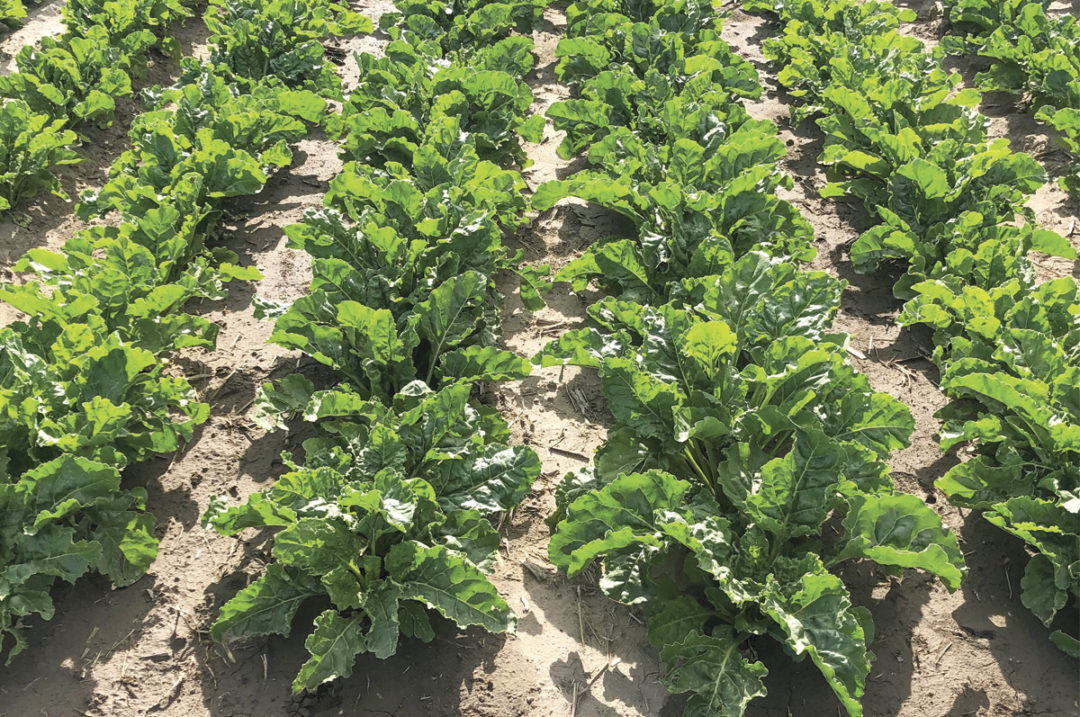Nitrogen and water
Root yield, sugar concentration and its extraction efficiency are main components of profitable sugarbeet production. Effective nitrogen (N) and irrigation water management are important for maximizing returns for growers from agronomic, environmental and economic viewpoints.
Why N is difficult to manage? Temporal variability in yield (variability over time) is caused by the mixed effects of rainfall frequency, soil and air temperatures, precipitation/temperature and landscape interactions, and soil characteristics. Variability in these conditions from one growing season to another has a major impact on both crop yield potential and the amount of N needed by the crop. Low soil N reduces root yield and decreases sugar accumulation.
Application of N in amounts exceeding crop need results in fast and vigorous leaf growth, but root development often suffers. High amounts of soil N also cause lower sugar extraction efficiency due to reduced sugar concentration and increased nitrate impurities in the roots. Impurities, such as nitrate N, stored in the sugarbeet roots hinder sugar extraction, which decreases the amount of recovered sugar (estimated recoverable sugar; ERS) from the harvested beets and increases sugar extraction costs. Concentrations of nitrate impurities in the beet roots should not exceed 200 parts per million (ppm) to optimize sugar content in the beets. The sugar content tends to decrease by 0.5% for every 100 ppm of nitrates. Higher sugar content in beet roots is typically associated with low available/non-excessive soil N during later growth stages.
Sugarbeets are considered one of the higher water-consuming crops, especially due to longer growing seasons. Appropriate irrigation amount and timing can optimize sugarbeet root yield, help to lower pest and disease pressure, deliver substantial water cost savings and prevent N loss through leaching. Nitrogen and water uptake is highly interactive: Crop response to applied N is strongly influenced by plant-available water levels, and vice versa. The benefits of applied N fertilizers are diminished in water-limited conditions. Excessive irrigation tends to produce larger sugarbeet roots with substantially lower sugar content. Soil moisture levels affect N release from applied fertilizers and organic soil N transformation to plant-available forms.
Visual crop monitoring versus drone-assisted scouting. Traditionally, producers conduct regular field scouting and visual observations to monitor crop growth and development.
Precision sensing is like “scouting on steroids.” Precision sensing can be done with hand-held/ground-based sensors and unmanned aerial vehicles (drones) equipped with cameras. This methodology is based on detecting and measuring the optical qualities of plants and their associated vigor and health properties. Crop-specific spectral features of canopy measured with camera-equipped drones can be used to evaluate physiological traits of crops.
Sensors have three main advantages over traditional visual crop evaluation
- Sensors are much more reliable and objective.
- Sensors provide quantitative information (numeric data that can be measured and compared) versus qualitative information (descriptive data that can be observed but not measured).
- Sensors can function within regions of the electromagnetic spectrum where human eyes are unable to operate.

A Matrice 100 UAV is equipped with a RedEdge M camera for the study. Photo provided by Olga Walsh.
Traditional vs. drone-guided fertilization
Nitrogen-responsive fields are those in which a noted positive response to applied fertilizer is indicated by improved yield and/or quality. It is normally recommended to apply all N to sugarbeet fields before planting. Preplant fertilization aims to ensure that N is available for plant uptake by four-six leaf growth stage in early June. However, recent field trials have shown that N application in sugarbeets can be easily delayed until later in the season without negatively impacting root yield and quality. This is because the N demand of the sugarbeet seedlings is low, and as early leaves mature the demand for N increases due to N required for taproot growth and development.
Having accurate estimates of yield and quality before the crop harvest is an important management tool for individual sugarbeet growers and the industry as a whole. The accuracy of the traditional soil- and plant-based methods for predicting sugarbeet demand for N and yield estimation is generally low. Drone-assisted remote sensing is a promising tool for in-season crop health monitoring and N and water management. In addition, drone-based images can be used for accurate in-season estimation of sugarbeet yield and quality. If yield and quality potential of the crop is known (with a high degree of accuracy) in June, then N fertilization can be done based on real-time crop reflectance data, and based on crop requirements for N, as detected by sensors.
Normalized Difference Vegetative Index (NDVI) is widely used in remote sensing of crops using drones. The NDVI values represent the amount of green vegetation produced by the plants relative to bare soil. The NDVI values accurately reflect the crop biomass production by measuring the difference between near-infrared light (mostly reflected by plants) and red light (absorbed and used by plants in photosynthesis). Precision sensing of tuber crops such as sugarbeets is typically more challenging and not as straightforward as for other crops like grasses. This is because the objective is to characterize the sugar-storing roots of sugarbeet plants located below ground. Our work offers a solid proof of concept that drone data can be used for accurate sugarbeet yield and ERS prediction in-season.
Field trials
Experiments were carried out to evaluate how accurate the drone-based data can help predict yield and ERS of sugarbeets grown under various N and water regimes. Field trials, funded in part by the Snake River Sugarbeet Research and Seed Alliance, were conducted at the University of Idaho, Parma Research and Extension Center in 2019 and 2020 growing seasons. Those findings are listed here.
- Overall, the effect of irrigation on sugarbeet root yield and ERS was more pronounced than the effect of applied N.
- The drone-based data collected in June predicted sugarbeet root yield with 65% accuracy, and ERS – with 75% accuracy. Data collected in July had higher accuracy of prediction: 91% and 95% for yield and ERS, respectively. The consistent trends in relationships between drone-based data and ERS indicate that spectral measurements may be used for accurate in-season estimation of ERS – the key quality parameter reflecting sugarbeet productivity.
- Determining the sugarbeet yield and ERS potential in late June/early July, and topdressing the crop before the end of July will help to maximize yield and quality, and improve N fertilizer use efficiency.
Next steps
Drone-assisted scouting and sensing can be done by individual crop producers on their farms. Flying a drone to support decision-making in farming operations is considered as “business purpose.” To fly a drone in the state of Idaho for any business purpose, the drone operator is required to take the FAA’s Aeronautical Knowledge Test. Obtaining the Remote Pilot Certificate is just the first step in utilizing drones. All drones weighing more than 0.55 pounds must be registered. Although many farmers and ranchers are getting more involved in operating drones, the flying is actually the easiest part.
The images obtained with drones must undergo multistep analysis using specialized software. This process takes a considerable amount of time and hands-on training of highly skilled professionals with expertise in soils, crops, agronomy and image analysis. This essentially converts images into numeric values that can be used to make field- and crop-specific recommendations. This is why it is recommended for growers to partner with a university researcher or a local company providing drone-related services for agricultural use.
The next step for developing grower recommendations is building an algorithm through extensive field trials across multiple seasons, growing conditions and varieties to ensure the accuracy of sugarbeet yield and ERS predictions. Growers interested in participating in drones for crop scouting projects are encouraged to contact their local extension outreach personnel in their county to explore future collaborations.
Sanaz Shafian and Jordan McClintick-Chess contributed to this article. Sanaz Shafian is an assistant professor in advanced technology and data analysis, Virginia Polytechnic Institute and State University, Blacksburg, Virginia. Jordan McClintick-Chess is a senior agriculturalist with Ag Idaho Consulting in Wilder, Idaho.








